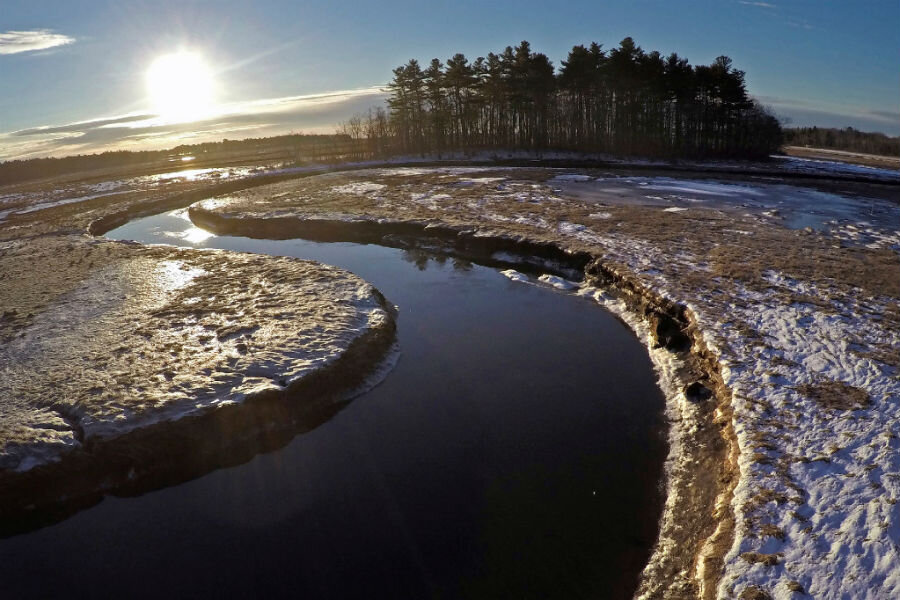Underappreciated and in trouble: Can we stave salt marshes' decline?
Loading...
Muddy salt marshes get a bum rap. They may not be as colorfully vibrant as the more glamorous tropical rainforests and coral reefs, but the salty bogs that edge coastlines around the world hold enormous ecological value, both as habitats for species that can live nowhere else and as a buffer for surging seas during storm events.
And, like the rainforests and reefs, salt marsh ecosystems are in trouble.
A recent study of eight salt marshes conducted by the US Geological Survey found that erosion in the marshes had led to a net decline in sediment in all of the biomes studied. The researchers predicted that four of the biomes, without direct action being taken to save them, would be gone within 350 years. While 350 years that might seem like a long time, this study is only the latest in a series of bad news for salt marshes in recent decades, as rising seas and human coastal development threaten to continue to encroach on these vital ecosystems.
"Coral reefs and tropical rainforests are pretty damn important, but salt marshes and coastal wetlands in general turn out to be the most valuable per area of any ecosystem on the planet." says Mark Bertness, a marine coastal ecology and conservation expert at Brown University in Providence, R.I. "Coral reefs protect shorelines, and they support biodiversity. Tropical rainforests in general store a lot of carbon.... But salt marshes do all these things."
Salt marshes form in sheltered areas between the sea and land as sediment is deposited and washed away with the tides, creating a highly salty, semi-terrestrial habitat for hundreds of animal, plant, and microbe species.
Because of wide temperature fluctuations, constant tidal changes, and other factors, a salt marsh might seem like a harsh place to live. But these conditions provide effective shelter for fish nurseries and for the development of young for certain coastal bird species. Perhaps more importantly, salt marshes provide significant "ecosystem services" for humans as well, Dr. Bertness tells The Christian Science Monitor in a phone interview.
The dense roots of plants native to salt marshes are effective at halting runoff and protecting coastlines from storm surges. And the ideal fish nursery conditions in the marshes are often taken advantage of by local hatcheries producing fish for human consumption. But according to the US Geological Survey study published late last month in the journal Nature Communications, the eight salt marshes under investigation were all experiencing a net sediment deficiency that, if unchecked, could eventually eliminate the marshes forever.
It is a potential fate that would likely not be confined to the marshes in the study.
"Somebody in 50 years who looks at some of the marshes we've looked at, they'll just see lots of open water," Joe Kelley, a University of Maine professor of marine geology who was not involved in the study told the Associated Press.
So what can be done to save the salt marshes?
There are a number of strategies, including dike construction and dredging, that have shown some success in maintaining a more sustainable balance of sediment in the marshes. Sometimes, though, the problem is not erosion, but the loss of plants that hold the sediment in place, often due to predation by animal species. One novel solution posited by Bertness is to actually introduce certain invasive species to marshes, such as reeds with denser root systems to hold down soil, or even supporting invasive crabs that keep other plant-eating crab species at bay.
"There's all sorts of mixed opinions," says Bertness. "[But] what's the target of restoration? Is it getting things back to the way we remember them, or is it getting these ecosystem services?"
As oceans rise, however, it will become increasingly difficult to maintain these drowning salt marshes as the sea continues to push inland, which necessitates different strategies. And these fragile ecosystems are experiencing threats from the other side as well, as humans seeking beachfront roads and property push further into the marshes, says Elizabeth Burke Watson, a professor and wetlands section leader at the Academy of Natural Sciences in Drexel University in Philadelphia.
"In the absence of humans, wetlands and their organisms can adapt," Dr. Watson tells the Monitor in an email. "However, human development along the upland boundary has the ability to disrupt potential inland migration pathways."
With human developments in the way, new salt marshes will not be able to develop in shallow areas as older marshes are swallowed up by the ocean. Watson says that "special attention and conservation actions" will be needed to help support any migration that may take place in the coming decades. But ultimately, she says, the salt marshes may need to see the effects of human-caused climate change reversed, or at least slowed, in order to protect the struggling ecosystems on a large scale.
"Reducing greenhouse gas emissions is the most important factor, because wetlands can naturally adapt to lower rates of sea level rise," she says. "So slowing sea level rise due to climate change would be really beneficial."






